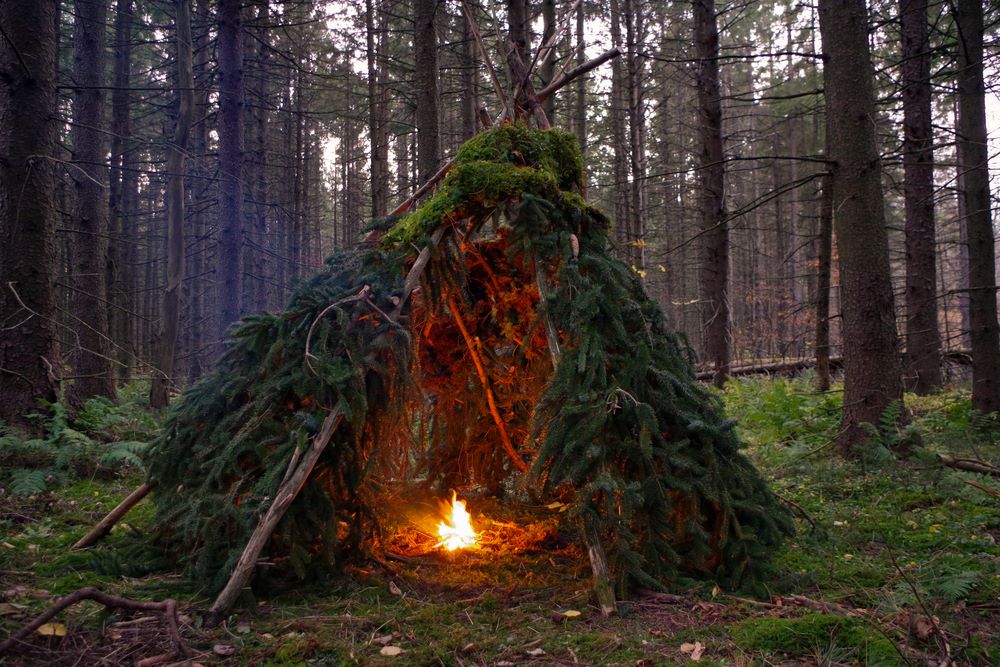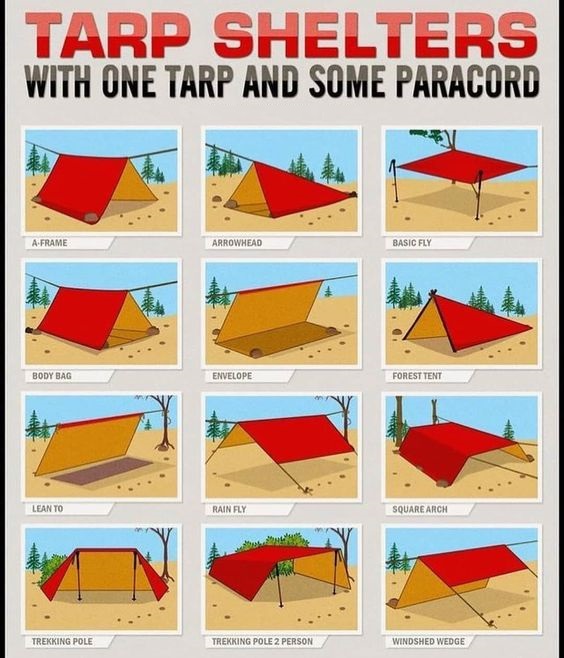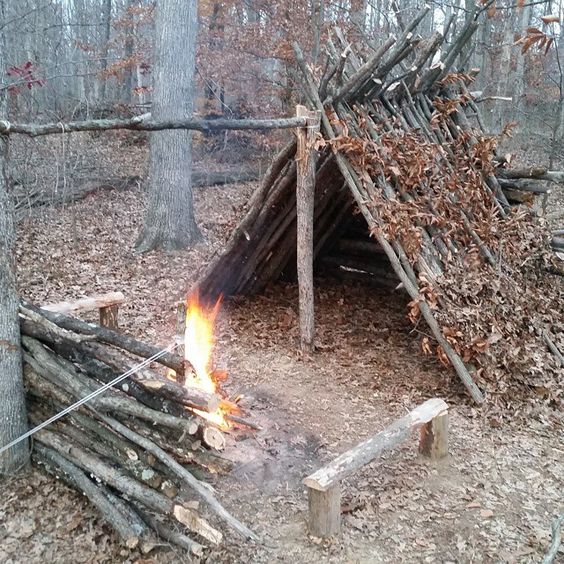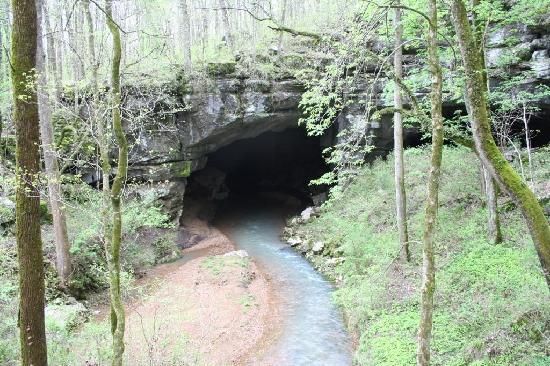Almost all of us have built something that we were proud of.
It may have been a garden shed, a dog house, or even a smaller project that you gifted to loved ones. While the building process was the most exciting part, the much-needed step to start with the overall project was the planning process. Without planning, you wouldn’t have been able to complete your task.
Building a shelter in the wilderness is no different than any of the above-mentioned projects. However, the planning part is the most critical one as it may affect your final project, and ultimately, your chance of survival.
I’ve seen many articles, videos, and what-not that cover the building process of various types of shelter. However, the planning part is barely covered since it’s not as interesting and exciting as the building process itself. In the wilderness, you need to avoid wasting time and energy, and only by planning your steps carefully, you will be able to construct a proper shelter.
The guidelines you will find below will give you a good start for planning and building a shelter, and you will be able to check and re-check your plan as you build on it. Before you jump headfirst and start chopping down trees, you will need to figure the answer for the following questions.
Shelter Planning
What is the purpose of your shelter, and how long should it last?
This is the number one question you should be asking yourself long before you start procuring the materials for your shelter. In some cases, you will need a simple shelter to protect you from the sun or from the wind. In others, you may need one to protect you from rain or snow, which may end up being a little more complex (more time and energy to build it).
This is an important thing to figure out because if you find yourself in an emergency situation, you should be able to build something to shelter you through the night.
In incremental weather, you may also need to incorporate a warming fire. This means that the shelter you are building should have enough room inside to move around and also allow you to cook your food or boil water.
In case you are building a temporary shelter and you are forced to use it for longer than predicted, you will still be able to build extensions around it if time allows it.
What resources do you have available?
Some preppers can improvise a shelter framework using a tarp or their bag to speed up the building process. However, there are some that would rather use those items to improve the protective and waterproof qualities of their new shelter.
Before you start gathering wood, chopping down trees and what now, think carefully about what other materials are available in the area and how you can use them. If your car is available, you can use it as a sturdy support for various types of shelters.
However, even using your vehicle as a temporary shelter has some drawbacks. In the winter, it can get very cold inside, and in the summer, it can turn into an oven. A wise prepper will know how to use everything from the car to make the shelter more comfortable. You can insulate your shelter from the ground by using the seats and carpets. The seat-belts can be used as survival cordage and so on. How about the horn? If it still works, you can use it to signal for help. The same goes for the mirrors.
What tools do you have available?
This is an equally important question to ask yourself because if you only have a pocket knife, big projects are out of the question. With a small knife, you won’t be able to cut strong poles for the mainframe and you are better off using fallen dead wood (it’s not ideal, but it will do).
All the greenwood you may have to harvest will be used for the main structure. Down the road, this will definitely influence your shelter design and durability.
Based on the resources and tools you have, you will design your shelter to avoid wasting time and energy.
Can you do it yourself, or do you need help building the shelter?
If you are alone in the wild, you should opt for building something simple that doesn’t require the assistance of another fellow human. However, if you are part of a group, you can get everyone involved in the building process. You can divide the workload based on numbers and knowledge/skills.
Even those that can’t give a helping hand can be put to work and they can gather firewood, carry water, or prepare food if need be.
The problem when building a shelter is that most folks envision something big and sturdy, and halfway through the building phase, they realize they don’t have the manpower to complete the project. Limit yourself to your resources and skills.
Is time a constraint?
People stranded in the wilderness will always be working on a deadline, and that deadline is the setting sun. To be able to get even the simplest shelter that provides a roof over your head and some sort of protection, you should know the local sunset time.
For example, if there’s not much remaining daylight, you are better off spending your time and energy collecting firewood to last you for the night. The next step would be to isolate your sleeping bag (or area) to be protected from the elements.
A full day provides you with enough time to build something more complex, but you should keep in mind that you need to have a place to rest your head by sundown. Shelter becomes the number one priority in an environment with incremental weather.
What size do you need your shelter to be?
This is something most people have no idea how to go on about. The type of emergency you are facing, and the number of people you need to shelter should be the main criteria for your planning phase.
A two-person shelter will be big enough to squeeze inside and use the body heat of the occupants to stay warm. If you have a larger group and you have to face colder conditions, you will need a larger design. You will need to build a shelter that can incorporate a fire to warm all the people. Most folks will set ambitious goals and go for something big. They don’t stop and think about the available building materials and the capabilities of their workforce.
When dealing with a larger group, you will need to use your environment and find a suitable spot for shelter building. For example, rock formation, caves, or any other natural structures will make your job a lot easier. Even so, one thing that you have to do is to draw rough markings on the floor to establish the limit of the shelter’s footprint. This becomes a mandatory step to be sure it is big enough for everybody in your group.
One tip I can give you is that once you have the footprint of your shelter, you should lay down in your sleeping position inside that footprint. By doing so, you will make sure you won’t undersize the shelter, and everyone has enough room in it.
Will local weather affect your shelter?
This is something I keep talking about and it is classified under the “know your region” topic. One should learn about the elements that require the building of the shelter. Knowing about which direction does the wind comes from will help you plan your shelter so that it faces away from that direction. The wind blowing direction also plays an important role when using a fire. You should know the type of fire you need to make based on how the wind is hitting your position.
Also, the sun position is critical to know, especially during the cold season when facing the sun may be the only thing keeping you warm. Learn where the sun rises and sets and look for unchanged snow patches. Those places are the last place when you want to set your shelter as they never see the sun, and they melt very slowly even during summertime.
What other dangers should you be aware of?
During the planning phase, one should take a good look at the environment and try to identify potential risks. Here are just a few things you should be aware of:
- Raising waters
- Floods
- Dangerous animals
- Falling tree and/or rocks
- Poisonous critters
- Avalanche
For example, one thing I always do before picking my camp area is to look for animal tracks. The last thing I want is to set my tent in the path of a large predator’s road. Another thing that I follow to the letter is to look for potential rockfall or widow makers (falling branches). Inspect your area properly before building your shelter!
How can you make your life easier when building the shelter?
This is another thing that must be considered, and I classify it under the work smart, not a hard category. If you are young and have good health, you may take on tasks that may be complicated for the average, couch dwelling citizen. However, if you’re not in your younger years and your energy levels are in short supply, you must think before you act.
Build your shelter next to your resources (building materials, firewood, and source of drinking water). If you do so, you will spend less time carrying them to your shelter. This will also help you save energy and you will have much more time for other survival tasks such as preparing food, providing first aid, or any other action that will help you boost your morale and regain your strength.
I always advise people to look for cave and rock overhangs as they have provided shelter for our ancestors for many thousands of years. If you set your eye on a coastal cave, you must first check it for indications of flooding.
In the wilderness, there is a general rule concerning any cave, and it states that you should carefully check them for any inhabitants that might harm you. If you notice a pile of bones or any other animal leftovers, it’s better if you stay away from it. Find something else to shelter you for the night.
You need to stay alert to the possibilities of exploiting a natural shelter and maybe, explore a little before picking the ideal spot for your site.
Concluding
Building a shelter can be an exciting experience in the wilderness if you have the time and resources at hand. However, when both time and weather are working against you, building a shelter will be the only thing that can save your life. To make sure you are not wasting time and energy, take a few minutes and plan it all in your head before building the said shelter. Down the line, you will be glad you did so.



























































































One topic you may want to consider adding is CAMOUFLAGE !
Some situations can present a need for you to be invisible to others. Therefore, different types and ways to accomplish this should be covered.
For example: I know of a Veteran that wanted to save enough money to buy a cargo van. People walked within twenty feet of the “shelter” for five years and never realized it was there.
Very true, Bob. Add to those features, use as much natural (and nearby) materials as possible. That will make your shelter less noticeable, or easy to see. I have known persons who would build a passable shelter, and then cover it with a lime-green tarp. Oh, Boy !